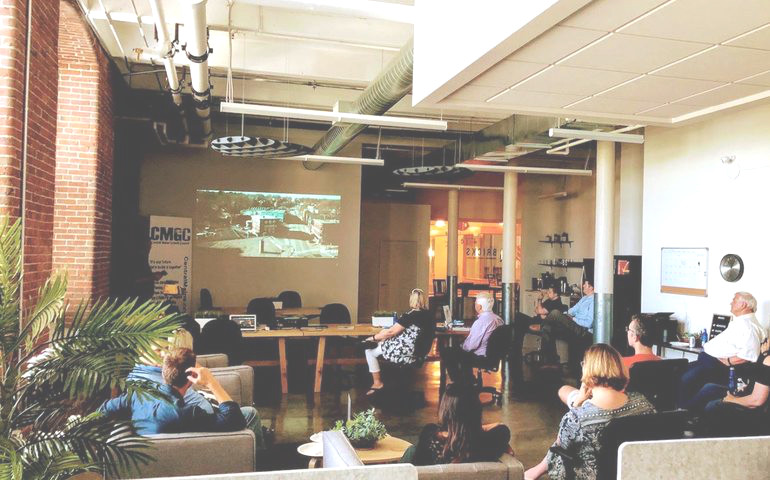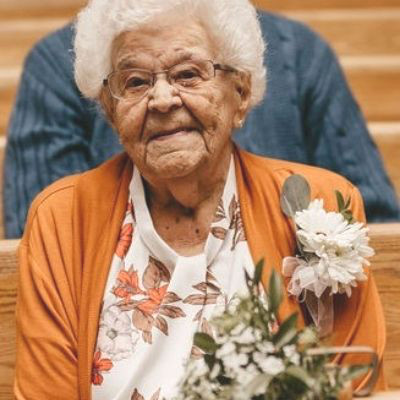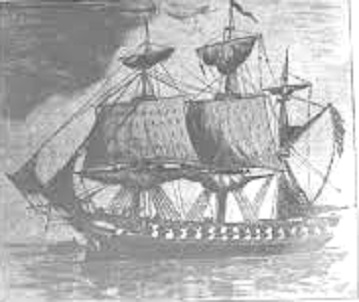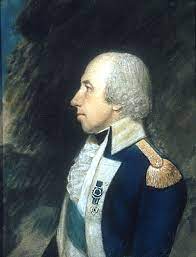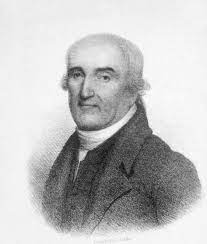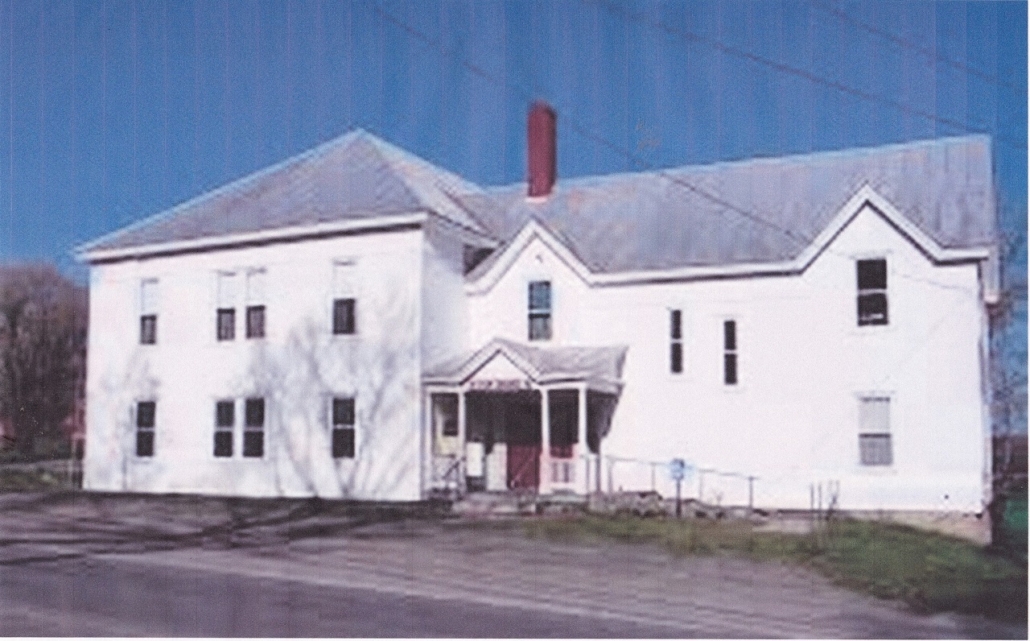Up and down the Kennebec Valley: Wars – Part 12
/0 Comments/in Albion, Augusta, China, Fairfield, Local History, Maine History, Palermo/by Website Editor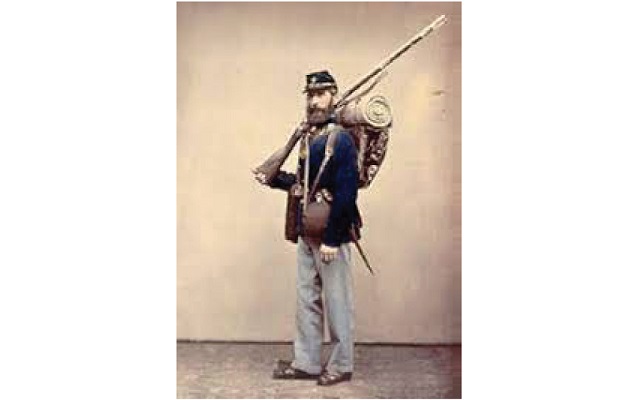
The Civil War left China, like Albion and other towns, deeply in debt, paying to outfit the soldiers and compensate their families.
by Mary Grow
Civil War
The United States Civil War, which began when the Confederates shelled Fort Sumter, South Carolina, on April 12, 1861, and ended with General Robert E. Lee’s surrender at Appomattox, Virginia, on April 9, 1865, had the most impact on Maine, including the central Kennebec Valley, of any 17th or 18th century war.
Nonetheless, your writer’s original plan was to write only a single article about the Civil War. As usual, she found an oversupply of material that she hopes will interest readers as it interested her; but she still limits coverage to two articles, for three reasons.
The first and most important reason to downplay Civil War history is that unlike, say, the War of 1812, the Civil War is already familiar. Citizens who know nothing about the Sept. 13, 1814, bombardment of Fort McHenry (which inspired Francis Scott Key to write the poem that became the national anthem) recognize at least the names of battles like Bull Run and Gettysburg. Many people can name at least one Civil War general; few can name one from the War of 1812.
A second point is that numerous excellent histories of the Civil War are readily available, including books specifically about Maine’s role.
And the third reason is that this war is recent enough that some readers undoubtedly have memories of their grandparents telling stories of the generation before them who fought in the Civil War.
Any reader who would like to share a family Civil War story is invited to write it, attach photographs if available and email to townline@townline.org., Att. Roland Hallee. Maximum length is 1,000 words. Submissions will be printed as space permits; the editor reserves the right to reject any article and/or photograph.
* * * * * *
Maine historians agree that the majority of state residents supported President Abraham Lincoln’s decision to fight to preserve the Union. Those who initially disagreed, James W. North wrote in his history of Augusta, found themselves a small enough minority so they either changed their views or moderated their expression.
By 1860, the telegraph was widely used. News of Fort Sumter reached Augusta the same day, followed two days later by Lincoln’s call for 75,000 three-months volunteers, including one regiment from Maine.
On April 22, North wrote, the Maine legislature, in a hastily-called special session, approved enrolling 10,000 soldiers in ten regiments for three years, plus “a State loan of one million dollars.”
Augusta had filled two companies by the end of April. Other Kennebec Valley companies joined them; they camped and drilled on the State House lawn. The Third Regiment started south June 5, 1861; those soldiers were promptly replaced by others from other parts of Maine, volunteers succeeded by men paid bounties and in 1863 by draftees.
North wrote that the first draft in Augusta was held July 14 through 21, 1863, starting two days after the New York City draft riots began, with news arriving hourly. In Augusta’s Meonian Hall, eligible men’s names were drawn from a wheel by a blindfolded man named James M. Meserve, “a democrat of known integrity and fairness, who possessed the general confidence.”
The process began with selection of 40 men from Albion. Augusta followed, and, North wrote, the initial nervousness gave way to “a general feeling of merriment,” with draftees being applauded and congratulated.
Being drafted did not mean serving, North pointed out. Physical standards were strict; out of 3,540 draftees, 1,050 were “rejected by surgeon for physical disability or defects.” It was also legal to pay a substitute or to pay the government to be let off.
Augusta remained a military hub and a supply depot through the war, centered around the State House and Camp Keyes, on Winthrop Hill, at the top of Winthrop Street. There were large hospital buildings on Western Avenue, North wrote, which were so crowded by 1863 that the Camp Keyes barracks were also fitted up as hospital wards. The trotting park between the State House and the river was named Camp Coburn and hosted infantry and cavalry barracks and enlarged stables.
North described the celebratory homecomings for soldiers returning to Augusta when their enlistments were up, like the one in August 1863 for the 24th Regiment. The “bronzed and war-worn” men had come from Port Hudson, Louisiana, up the Mississippi to Cairo and by train to Augusta, a two-week trip. Greeted by cannon-fire, bells, torch-carrying fire companies, a band, state and city officials and “a multitude” of cheering citizens, they marched straight to the State House, enjoyed a meal in the rotunda and “dropped to sleep on the floor around the tables, being too weary to proceed to Camp Keyes.”
Historians describing the effects of the Civil War on smaller Kennebec Valley towns tend to emphasize two points: the human cost and the financial cost.
Ruby Crosby Wiggin found as she researched the history of Albion a record saying that “out of 100 men who went to war from the town of Albion, 45 didn’t come back.” She listed the names of more than 150 Albion soldiers, six identified as lieutenants.
By 1862, Wiggin wrote, the state and many towns offered enlistment bonuses. In addition, towns paid to equip each soldier. Total Albion expenditures, she wrote, were $21,265; the state reimbursed the town $8,033.33.
Wiggin concluded, “No wonder the town was heavily in debt at the close of the Civil War.”
The China bicentennial history says almost 300 men from that town served in Civil War units. The author quoted from the 1863 school report that said attendance in one district school was unusually low, “the large boys having gone to the war.”
The Civil War left China, like Albion and other towns, deeply in debt. The China history says when the State of Maine began tallying municipal costs and offering compensation in 1868, China had paid $47,735.34 to provide soldiers. The state repayment was $12,708.33, and town meetings were still dealing with interest payments and debt repayments into the latter half of the 1870s.
China town meetings during the war were mostly about meeting enlistment quotas, and, the history writer implied, by 1864 voters were tired of the topic. In July and again in December 1864, they delegated filling the quota to their select board.
When the late-1864 quota had not been filled by February 1865, voters were explicit; the history writer said they agreed to “sustain the Selectmen in any measures they may take in filling the quota of this town.”
The Fairfield historians who wrote the town’s 1988 bicentennial history found the list of Civil War soldiers too long to include in their book and noted that the names are on the monument in the Veterans Memorial Park and in the Grand Army of the Republic (G.A.R.) record books in the public library across Lawrence Avenue from the park.
Of Larone, the northernmost and likely the smallest of the seven villages that made up the Town of Fairfield for part of the 19th century, the history says, “Larone furnished her full quota of ‘boys in blue’. These averaged one for every family, three-fifths were destined never to see their homes again.”
Millard Howard, in his Palermo history, wrote that “The Civil War was by far the most traumatic experience this town ever experienced.” Of an 1860 population of 1,372, 46 men, “or one out of every 30 inhabitants,” died between 1861 and 1865.
Looking back from the year 2015, Howard wrote somberly, “No other war can remotely compare with it.”
He listed the names of the dead, with ages and causes of death where known. The youngest were 18, the oldest 44. More than half, 26, died of disease rather than wounds; Augustus Worthing, age 31, starved to death in Salisbury prison, in North Carolina.
Sidney voters spent a lot of town meetings in the 1860s talking about the war, according to Alice Hammond’s town history. As early as 1861, they approved abating taxes for volunteers.
As the war went on, voters authorized aid for volunteers’ families and monetary inducements to enlist for residents and non-residents, with preference given to residents. At an 1863 special meeting, they authorized selectmen to borrow money as needed “to aid families of volunteers.”
Hammond noted that Sidney was debt-free before the war, “but in 1865 it issued bonds for $24,000, a debt from which it recovered very slowly.”
Alma Pierce Robbins found from military records that 410 men from Vassalboro enlisted for Civil War service. From census records, she listed the 1860 population as 3,181.
As in other municipalities, voters approved wartime expenses. Robbins wrote that $7,900 was appropriated for bounties and aid to soldiers’ families in 1861. The comparable 1863 figure was $16,900. Perhaps for contrast, she added the 1864 cost of the new bridge at North Vassalboro (presumably over Outlet Stream): $1,057.82 (plus an 1867 appropriation of $418.62).
In Waterville, General Isaac Sparrow Bangs wrote in his chapter on military history in Reverend Edwin Carey Whittemore’s 1902 centennial history, recruiting offices opened soon after the news of Fort Sumter. A Waterville College student named Charles A. Henrickson was the first to enroll, and, Bangs wrote, his example “proved so irresistibly contagious at the college that the classes and recitations were broken up” and the college temporarily closed.
Henrickson was captured at the Battle of Bull Run, July 21, 1861. He survived the war; later in the Waterville history, Chas. A. Henrickson is listed among charter members of the Waterville Savings Bank, organized in 1869.
These Waterville soldiers became companies G and H in the 3rd Maine Infantry, Bangs wrote. After drilling in Waterville, they went to Augusta and were put under the command of regimental Colonel Oliver O. Howard. On June 5, Howard was ordered to Washington, “carrying with him, as Waterville’s first contingent, seventy-four of her boys into the maelstrom of war.”
Bangs spent years verifying the names of 421 men who either enlisted from Waterville or were Waterville natives who enlisted elsewhere. The names are included in Whittemore’s history.
Bangs added that the Maine Adjutant-General’s report says Waterville provided 525 soldiers. He offered several explanations for the discrepancy, pointing out the difficulties of accurate record-keeping.
Waterville paid $67,715 in enlistment bounties, Bangs wrote. Henry Kingsbury, in his history of Kennebec County, put the figure at $68,016 and said the state reimbursement was $19,888.33.
Linwood Lowden wrote in the history of Windsor that more than one-third of Windsor men aged 17 to 50 fought in the Civil War, most of them in the19th and 21st Maine infantry regiments.
Like other towns, Windsor paid bonuses to enlistees and, Lowden wrote, $2,663.87 “in aid to soldiers’ families…from 1862 through 1866.” He added that Windsor first went into debt during these years.
Camp Keyes, Augusta
A history of Camp Keyes found on-line says that the 70-acre site on top of Winthrop Hill, on the west side of Augusta, had been used as, and called, “the muster field” since before Maine became a state in 1820. It was still available, although the militia had become less significant, when the Civil War broke out.
On Aug. 20, 1862, Maine Adjutant General John L. Hodsdon designated the field one of Maine’s three official “rendezvous areas” for militia and volunteers and named it Camp E. D. Keyes, in honor of Major-General Erasmus D. Keyes, a Massachusetts native who moved to Kennebec County (town unspecified on line) as a young man. He graduated from the United States Military Academy in 1832 and fought in the Civil War until 1863, when a superior removed him from command, claiming he lacked aggressiveness.
(The other two Maine rendezvous areas were Camp Abraham Lincoln, in Portland, and Camp John Pope [honoring General John Pope from Kentucky], in Bangor.)
Thousands of Civil War soldiers from Maine passed through Camp Keyes. It also housed Maine’s only federal military hospital, named Cony Hospital in honor of Governor Samuel Cony.
After the war, the site remained a militia training ground. The State of Maine bought it in 1888. In 1893 the militia became the National Guard and continued to use the training ground, with Guard headquarters in the Capitol building until 1938.
The on-line site gives an undated description: “Small buildings were constructed of plywood for mess halls, kitchens, latrines, store houses, and lodging for senior military officers. Companies pitched their tents on pads that had been built.”
Main sources
Fairfield Historical Society Fairfield, Maine 1788-1988 (1988).
Grow, Mary M., China Maine Bicentennial History including 1984 revisions (1984).
Hammond, Alice, History of Sidney Maine 1792-1992 (1992).
Howard, Millard, An Introduction to the Early History of Palermo, Maine (second edition, December 2015).
Kingsbury, Henry D., ed., Illustrated History of Kennebec County Maine 1625-1892 (1892).
Lowden, Linwood H., good Land & fine Contrey but Poor roads a history of Windsor, Maine (1993).
Marriner, Ernest, Kennebec Yesterdays (1954).
North, James W., The History of Augusta (1870).
Robbins, Alma Pierce, History of Vassalborough Maine 1771 1971 n.d. (1971).
Whittemore, Rev. Edwin Carey, Centennial History of Waterville 1802-1902 (1902).
Wiggin, Ruby Crosby, Albion on the Narrow Gauge (1964).
Websites, miscellaneous.
FAIRFIELD: Town to hold public hearing to review PFAS report on drinking water expansion
/0 Comments/in Community, Fairfield, News/by Website Editor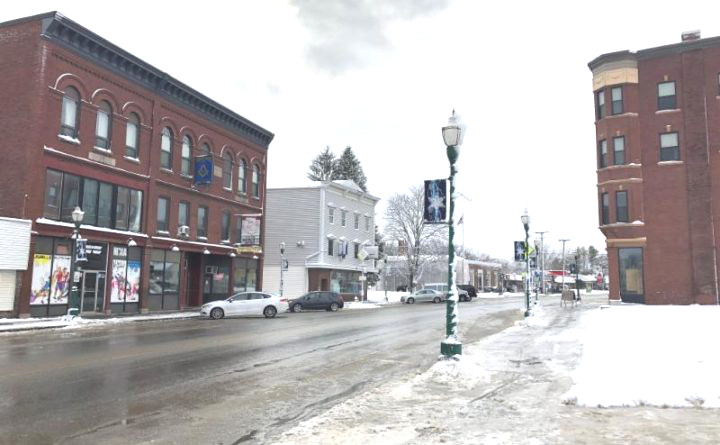
Looking south down Main St., in Fairfield. (Internet photo)
The Town of Fairfield will be holding a public hearing at the Fairfield Community Center, located at 61 Water Street, on Wednesday, March 23, at 6:30 p.m., to discuss the recently completed report by Dirigo Engineering and associated options for extending public drinking water. At the hearing, members of the public will have the opportunity to review potential changes to public water infrastructure within the town.
Community members and residents are encouraged to attend in-person, with a virtual hearing option available as well.
“Providing a public forum for the town’s residents to understand the proposed project and report will assist the Town of Fairfield in educating the public, achieving clean drinking water goals, and addressing impacts related to PFAS contamination,” states Fairfield Town Manager Michelle Flewelling. “The town’s priority is and will continue to be the well-being of its residents, and allowing the public to ask questions and submit feedback will help address this challenge going forward.”
Hired through a recent RFQ process, Dirigo Engineering has completed a feasibility report to assist the town with determining necessary water infrastructure extensions needed within the bounds of the municipality. Dirigo Engineering, based in Fairfield, is a consulting firm that provides professional services through civil engineering, with specialties including wastewater engineering, environmental services, and water supply engineering.
Additional information regarding the municipality’s ongoing PFAS investigation, including the Dirigo Engineering Report, can be found on the town’s website: www.fairfieldme.com.
For questions or additional information, please contact the Town of Fairfield at 207-453-7911 or info@fairfieldme.com.
Dirigo Labs announces selection as AWS activate provider
/0 Comments/in Community, Fairfield, Oakland, Waterville, Winslow/by Website EditorDirigo Labs, Maine’s newest accelerator program, has been designated as an Amazon Web Services (AWS) Activate Provider, allowing Dirigo Labs-based startups and entrepreneurs to access exclusive benefits to help accelerate growth as they build their respective businesses. The accelerator, launching its first cohort in March, will host approximately 10 Maine-based startups representing a range of industries including biotechnology and information technology.
Startups affiliated with Dirigo Labs who are building or about to start building web-based programs on AWS may apply for the AWS Activate Portfolio and receive free AWS credits, technical support, training, resources, and more. Inclusion in the Activate program differentiates the Dirigo Labs accelerator as an important solution to the maturation of startups building and scaling their companies on AWS.
“Being designated as an AWS Activate Provider will allow Dirigo Labs participating founders access to an exclusive toolset to help them succeed at every stage of their development,” states Dirigo Labs Managing Director Susan Ruhlin. “We welcome all cohort members to take full advantage of these incredible benefits.”
Dirigo Labs will offer a 12-week curriculum for seed-stage entrepreneurs scaling their startups. Topics will include product development, fundraising strategies, revenue modeling, and pitch refinement. Utilizing regional assets to encourage job creation and retention while improving access to capital for startups, Dirigo Labs is building an innovation ecosystem that supports entrepreneurship and showcases central Maine as a destination for business development and success.
“Joining an impressive portfolio of AWS Activate Program companies, including Coinbase and Toast, Dirigo Labs will provide opportunities and services to startups in our accelerator that they wouldn’t have had access to before, such as AWS Cloud credits, AWS business support, and access to the Activate console to help their business prosper,” elaborates Central Maine Growth Council Development Coordinator Sabrina Jandreau. “We look forward to working with our startups to utilize these opportunities while supporting rural business development for years to come.”
Startups and potential mentors interested in learning more about Dirigo Labs and submitting an application can visit www.dirigolabs.org.
Dirigo Labs is a regional startup accelerator based in Waterville, Maine. With a mission to grow mid-Maine’s digital economy by supporting entrepreneurs who are building innovation-based companies, the Dirigo Labs ecosystem brings together people, resources, and organizations to ensure the successful launch of new startups. Dirigo Labs operates under Central Maine Growth Council and is supported by several organizations, academic institutions, and investment firms.
Fairfield woman celebrates 100th birthday
/0 Comments/in Community, Fairfield/by Website EditorGladys Benner, a resident of Fairfield and shared over 50 years with her now deceased husband, Harlan (Bud) Benner, celebrated her 100th birthday on February 5, 2022. She has two children, three grandchildren and four great-grandchildren.
She had worked at the creamery, in Fairfield, when first moving to Fairfield. She had also worked in a local chair factory and woolen mills. She was a creative lady and her last years of working were as a florist at Sunset Greenhouse, in Fairfield. She retired from there to help take care of her grandchildren. She was a care-taker most of her life. She cared for her grandmother until her death, as well as her mother-in-law, and for a neighbor for many years.
She credits her sharpness to playing solitaire and doing crosswords puzzles every day. She was even found “dancing” from her wheel-chair at her great-granddaughter’s wedding this past fall, and was one of the last to leave that night. She is known for always having a smile on her face.
Up and down the Kennebec Valley: Wars – Part 4
/0 Comments/in Albion, China, Clinton, Fairfield, Local History, Maine History/by Mary Growby Mary Grow
Revolutionary War veterans from Albion, China, Clinton, Fairfield
Note One: this article and next week’s will be about a few of the Revolutionary War veterans who lived in the central Kennebec Valley. Selection is based on two criteria: how much information your writer could find easily, and how interesting she thought the information would be to readers. There is no intent to disparage veterans who are omitted.
Note Two: Alert readers will have noticed in last week’s piece that artist Gilbert Stuart was misnamed Stuart Gilbert. Your writer accepts blame for carelessness; she also assigns blame to Mr. and Mrs. Stuart, for giving their son two last names, or two first names, depending on your perspective.
* * * * * *
Ruby Crosby Wiggin wrote that town and state records and cemetery headstones identify more than a dozen Albion residents who were Revolutionary War veterans. Two, Francis Lovejoy and John Leonard, were among early settlers.
Rev. Francis Lovejoy, grandfather of Elijah Parish Lovejoy, was in Albion by 1790. Wiggin found that he served initially in “Colonel Baldwin’s regiment” and later re-enlisted to fill the quota from his then home town, Amherst, Massachusetts.
(Colonel Baldwin was probably Loammi Baldwin [Jan. 10, 1744 – Oct. 20, 1807], who fought at Lexington and Concord in the Woburn [Massachusetts] militia. He later enlisted in the 26th Continental Regiment, quickly became its colonel and commanded it around Boston and New York City until health issues forced him to resign in 1777. Wikipedia identifies him as the “Father of American Civil Engineering” and the man for whom the Baldwin apple is named.)
Wiggin gave no information on John Leonard’s military service. By Oct. 30, 1802, he owned the house in which Albion (then Freetown) voters held their first town meeting. Wiggin wrote that he held several town offices between then and 1811, when his name disappeared from town records.
* * * * * *
A veteran who settled in what is now China, and whose story has been increasingly revealed in recent years, was Abraham Talbot (May 27, 1756 – June 11, 1840). In various on-line sources, his first name is also spelled Abram, and his last name Talbart, Tallbet, Tarbett, Tolbot and other variations.
Talbot was a free black man. He was an ancestor of Gerald Talbot, the first black man elected to the Maine legislature. Gerald Talbot’s daughter, Rachel Talbot Ross, is assistant majority leader in the current Maine House of Representatives.
Born in Bridgewater, Massachusetts, to Toby (or Tobey) Talbot, also a Revolutionary War veteran, Abraham Talbot enlisted in the Massachusetts Line in July 1778 and served his nine months’ term at Fishkill and West Point, New York, until March 1779. He married Mary Dunbar in his home town on Sept. 3, 1787.
When he applied for his pension in 1818, he owned an acre of land in China with a small house on it. He and Mary were the only ones living there, although they had had eight children, born between December 21, 1787, and Feb. 16, 1805, in Freetown (now Albion).
William Farris (1755 – Oct. 19, 1841) was another veteran who in 1832 applied for his pension from China, having previously lived in Vassalboro from either 1796 or 1802 (sources differ). He was a native of Yarmouth, Massachusetts, and on Oct. 5 1775, married Elizabeth Burgess of that town.
An on-line history says he enlisted three times in three regiments: Nov. 1, 1775, for two months in Colonel Putnam’s regiment; February 1775 (a misprint for 1776, as the writer says he enlisted “again”) for two months in Colonel Carey’s regiment; and April or May 1776 for four months in Colonel Berckiah Bassett’s regiment.
His first terms were spent building fortifications in Cambridge and Dorchester, outside Boston. His third enlistment ended in the fall of 1776 on Martha’s Vineyard, “guarding the shore.”
(Colonel Putnam was probably Rufus Putnam [later a Brigadier General], a French and Indian War veteran who was instrumental in building the fortifications that forced British troops to evacuate Boston in mid-March 1776. Colonel Carey was probably Colonel Simeon Cary, commander of “the Plymouth and Barnstable County regiment of the Massachusetts militia,” which was at the siege of Boston. This writer failed to find Colonel Bassett on line.)
William and Elizabeth Farris had “at least eight children.” After she died around 1805, on March 18, 1806, he married a 22-year-old Vassalboro woman, Martha “Patty” Long. He bought a piece of land in Vassalboro in 1816, but was a China resident by 1832. His annual pension amounted to $33.33.
The China bicentennial history lists seven other early residents who were Revolutionary War veterans, including Joseph Evans. Evans, for whom Evans Pond is named, arrived in 1773 or 1774 and left his wife and children in the wilderness when he enlisted.
* * * * * *
Michael McNally (about 1752 – 1848), sometimes spelled McNully, was a veteran who ended his life in Clinton. He served in the Pennsylvania Line up to 1781. An 1896 on-line source says his descendants claimed that his role was driving the horses that pulled cannons.
Family stories reproduced on line give two accounts of his arrival in Pennsylvania: one says he was born as his family emigrated from Ireland, the other that as a youngster he ran away from home and crossed the Atlantic alone. He settled in Clinton around 1785 and “raised a large family.”
* * * * * *
The Fairfield Historical Society writers who produced the town’s bicentennial history in 1988 listed four early settlers who served in the Revolutionary army and 10 veterans who moved in after the war (eight from Massachusetts, one from New Hampshire and one from Georgetown, Maine).
The most prominent was William Kendall (1759 – 1827), referred to in one section as General William Kendall. The history says he enlisted from Winslow in March 1777 and obtained an honorable discharge in 1780. An on-line source says he was a drummer “in various New England regiments.”
Having bought most of the area that is now downtown Fairfield, including an unfinished dam and mill building, Kendall completed that project and added saw and grist mills in 1781. The village center was called Kendall’s Mills until 1872.
On Christmas Day 1782, Kendall paddled up the Kennebec to Noble’s Ferry (Hinckley) in his birchbark canoe and came back with his new wife, Abigail Chase. The couple lived first in a log house by the river at the foot of present Western Avenue, then in Fairfield’s first frame house and later in a large brick house at the corner of Newhall Street and Lawrence Avenue. The last housed Bunker’s Seminary (briefly mentioned in the Oct. 21, 2021, issue of The Town Line); it was torn down in the 1890s.
The Fairfield history says Kendall served eight years as a selectman. An on-line source adds that he was Kendall’s Mills postmaster in 1816, Somerset County Sheriff and a member of the first Maine Senate. He and Abigail had eight sons and three daughters. Kendall is buried in Fairfield’s Emery Hill Cemetery.
The cemetery, on the river side of Route 201 at the foot of Emery Hill, is near the site of the log house built by Jonathan Emery in 1771 that is called the first house built in Fairfield. Jonathan’s son David (born in Massachusetts Sept. 24, 1754) was one of the four Revolutionary soldiers who enlisted from Fairfield. The historians doubt the story that he enlisted in September 1775, inspired by Colonel Benedict Arnold’s troops marching up the Kennebec on the way to Québec, because dates don’t match.
They did find records showing that David Emery joined the Second Lincoln County Regiment on Mach 12, 1777. On Feb. 2, 1778, he transferred to the Continental Army, where he became part of General George Washington’s personal guard. After being mustered out Jan. 23, 1779, he came back to Fairfield and on April 5, 1782, married Abigail Goodwin. He died in Fairfield; one on-line source gives his date of death as Nov. 18, 1830, another as Nov. 18, 1834.
The other three early settlers who fought in the war were Josiah Burgess (1736 – 1828), a lieutenant from March 1776 to March 1779 in the First Barnstable Company from his home town of Sandwich, Massachusetts; his younger brother Thomas (1741 – 1820), who served in Josiah’s company for a week; and Daniel Wyman (1752 – 1829), who moved up the river from Dresden to Fairfield in 1774 and served three years in the Second Massachusetts Line. After independence, each Burgess brother served as a Fairfield selectman and Thomas was town treasurer for two years.
Jonathan Nye (November 1757 – September 1854) was born in Sandwich, Massachusetts, and is identified on line as serving as a private in 1775 and 1776 at Elizabeth Islands, first in Captain John Grannis’s company and later in Captain Elisha Nye’s company.
(The Elizabeth Islands are an island chain south of Cape Cod and west of Martha’s Vineyard; they compose the town of Gosnold, Massachusetts, named after the British explorer Bartholomew Gosnold, the first European to visit them, in 1602.
(John Grannis was a captain of marines, identified in several on-line sources as spokesman for America’s first whistle-blowers. In February 1777, nine shipmates aboard the frigate “Warren” chose him to jump ship and carry to the government in Philadelphia their charge that Esek Hopkins, in charge of the Continental Navy, was “unfit to lead.” The Continental Congress fired Hopkins.)
The Fairfield history says after Nye’s first one-year enlistment, he enlisted again from Sandwich in the spring of 1777. He was at Saratoga when Burgoyne surrendered and at Valley Forge during the winter of 1778. At some point he became a sergeant. He was honorably discharged at West Point March 7, 1780. After that, the history says, he enlisted yet again for short terms and served on privateers.
The on-line source names his first wife as Mercy Ellis from Sandwich. The bicentennial history calls her Mary Ellis, and says Nye married her “soon after his discharge [in the early1780s, then] and settled in Fairfield.” The history also says that in the spring of 1835, when Nye applied for one of the land grants Congress had just authorized, he said he had lived in Fairfield for 35 years, indicating he moved there in 1800. And in an account of the Nye family in another section of the book, Jonathan Nye is said to have moved from Sandwich to Fairfield in 1788, with his cousins Bartlett (August 1759 – 1822), Bryant and Elisha (Nov. 2, 1757 – 1845) Nye.
On March 18, 1820, Jonathan Nye married again, to Abigail Fish, who died in 1850. When he applied for a military pension in 1820, he said she was not strong enough to help with their farm, and he could not do much because of “blindness caused by small pox while in the army and a lameness in both knees.”
Jonathan Nye’s cousins Bartlett and Elisha were also Revolutionary veterans. Bartlett Nye, according to an on-line family history, served from July 2 to Dec. 12, 1777, in Rhode Island and Massachusetts and again for four days, Sept. 11 through Sept. 14, 1779, as a corporal in Colonel Freeman’s regiment responding to “an alarm at Falmouth [Massachusetts].”
(Colonel Freeman was probably Nathaniel Freeman (March 28, 1741 – Sept. 20, 1827) from Sandwich. He had a medical practice, became active in the Revolutionary movement as early as 1773, was a militia colonel from 1775 and a militia brigadier general from 1781 to 1791.)
Elisha Nye was also in Colonel Freeman’s regiment. He is listed on line as serving for several very brief periods in 1778 and 1779.
After the war, each of the brothers held political office. In 1812, Bartlett Nye was in the Massachusetts General Court, where he supported making Maine a separate state; his term had ended before the decision was taken in June 1819. Elisha, the Fairfield history says, “served as Representative from the County” in 1816, presumably also to the Massachusetts General Court.
Main sources
Fairfield Historical Society, Fairfield, Maine 1788-1988 (1988).
Grow, Mary M., China Maine Bicentennial History including 1984 revisions (1984).
Kingsbury, Henry D., ed., Illustrated History of Kennebec County Maine 1625-1892 (1892).
Wiggin, Ruby Crosby, Albion on the Narrow Gauge (1964).
Websites, miscellaneous.
Fairfield’s Cops Care for Kids Christmas program completes 15 years
/0 Comments/in Community, Fairfield/by Website Editor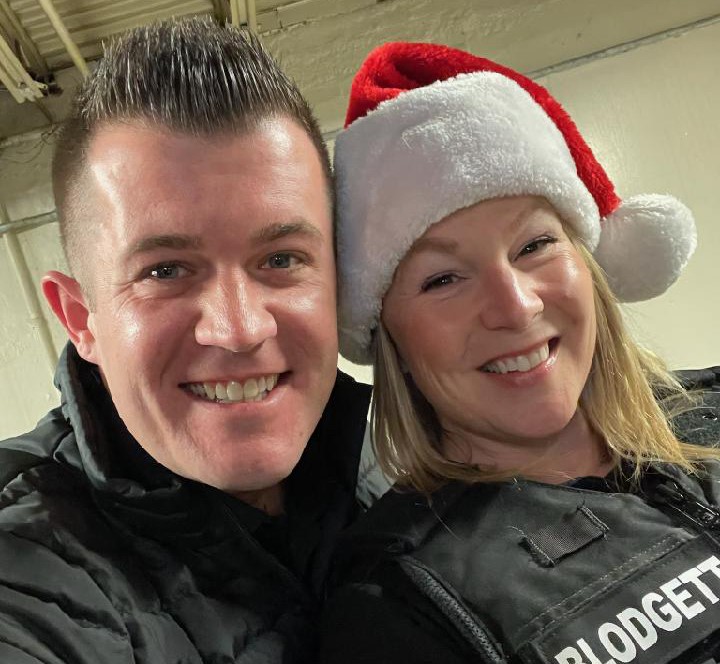
Scott King, left, President and CEO of CrimeShield, and Officer Shanna Blodgett helped distribute gifts to Fairfield children at Christmas. (contributed photo)
by Mark Huard
The Cops Care for Kids Christmas Program was started 15 years ago by Kingston Paul, of the Fairfield Police Department, to help create a positive relationship between the children of the community and the police officers at the department. What started out as delivering one stuffed animal with a Christmas tag to 40 kids has grown into delivering three small gifts along with their signature stuffed animal and tag to over 250 children. The officers donate money out of their paychecks every week, all year long to help keep the program going along with donations from the community and an amazing donation from Kingston before he passed away to ensure the program carries on.
Shakespeare group prepares for tea, Macbeth
/0 Comments/in Augusta, Community, Events, Fairfield/by Website Editor Recycled Shakespeare Company (RSC) is holding a fundraiser, A Literary Tea, on a Sunday , January 2, 2022, at 2 p.m. Enjoy hot tea and lovely desserts while listening to winter poetry, passages of prose and music performed by Recycled Shakespeare Company and Friends, in the warm and inviting hall of the historic South Parish Congregational Church, 9 Church Street, in Augusta, ME.
Recycled Shakespeare Company (RSC) is holding a fundraiser, A Literary Tea, on a Sunday , January 2, 2022, at 2 p.m. Enjoy hot tea and lovely desserts while listening to winter poetry, passages of prose and music performed by Recycled Shakespeare Company and Friends, in the warm and inviting hall of the historic South Parish Congregational Church, 9 Church Street, in Augusta, ME.
Tickets are $20 and make wonderful Christmas presents for a memorable day. Seating is limited, and must be reserved by December 24, so buy early. Please text or call Lyn at 207-314-4730 for tickets or send comments on the RSC Literary Tea Facebook event page. Your purchase supports free community Shakespeare theater.
If you purchase a ticket and would like to join our readers, please contact Lyn by December 19 with your selection – or we can choose for you. Pre-approved original poetry is welcome.
Meanwhile RSC is preparing to perform Macbeth, March 24 – 27, 2022, in Augusta, Dover-Foxcroft and Fairfield. All parts large and small, as well as assistants, are open for auditions; and in RSC tradition all who want a part get a part. Ages 12 to 112 are welcome to audition. Those interested in main parts may come prepared with a monologue if you choose, and group readings will also be requested. Auditions will be held from 5 to 7 p.m., on Tuesday, December 28, at the South Parish Congregational Church, 9 Church Street, Augusta, and on Wednesday, December 29, at Fairfield House of Pizza – home of Pizza and Play, 207 Main Street, in Fairfield. For more information please text or call Lyn Rowden at 207-314-4730.
EVENTS: Victor Grange to host Christmas with the Clauses
/0 Comments/in Events, Fairfield/by Website EditorVictor Grange #49, in Fairfield Center, invites all area children, and their parents, to enjoy Christmas with the Clauses, from 1 to 4 p.m., Saturday, Dec. 11, at the Grange Hall. Children can decorate a cookie with Mrs. Claus, sign a Christmas card for a veteran or nursing home resident, make an ornament and share their Christmas wishes with Santa.
Admission is free; hot chocolate will be provided. For more information, please call Barbara at 303-0717.
* * * * * *
Victor Grange #49, in Fairfield Center, is seeking area owners of snowplowing equipment who are willing to plow the paved parking lot for free for one snowstorm this winter. The work will be treated as a tax-deductible donation and receipts will be provided.
The Grange Hall is at the intersection of Routes 23 and 104 in Fairfield Center.
Those who would like their names on a list of potential donors are asked to call Roger at 453-7193 or Barbara at 303-0717.
Grange members hope to keep their newly-insulated building open for public events all winter.
PHOTO: Lawrence girls varsity, JV basketball team
/0 Comments/in Fairfield, School News, Sports/by Website Editor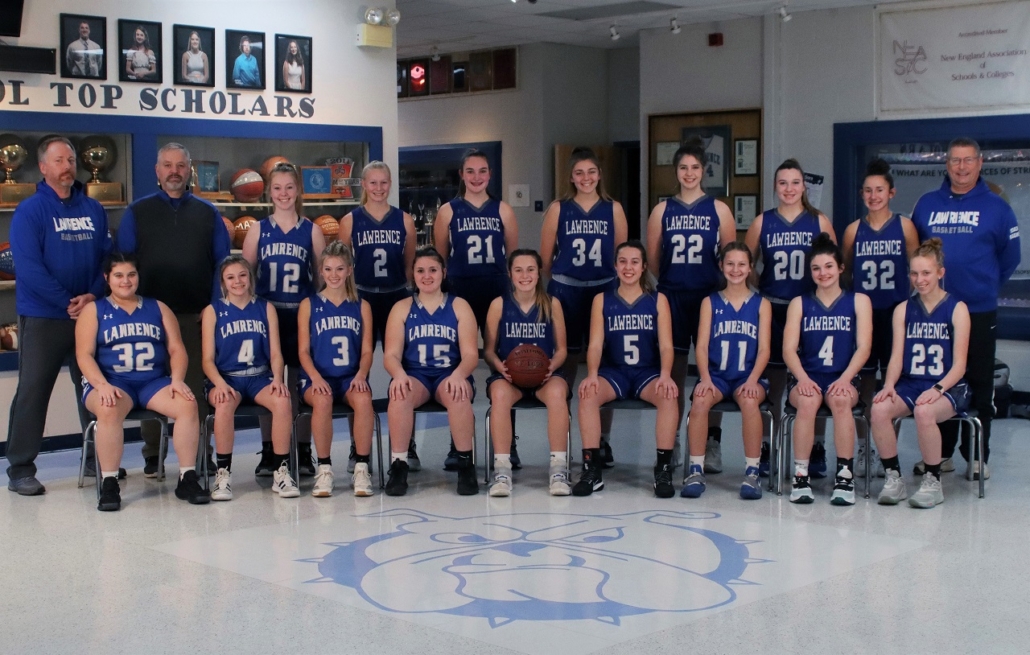
Front row, from left to right, Trinity Brickett, Amy Boyce, Maddy Niles, McKenzie MacAvoy, Emily Hagerty, MaKenzie Nadeau, Taylor Pellerin, Kaylee Elkins and Lizie Dumont. Back, Head Coach Greg Chesley, Assistant Coach Rusty Mercier, Maylie Knox, Ali Higgins, Lily Gray, Brianna Poulin, Nadia Morrison, Elizabeth Crommett, Hope Bouchard, Assistant Coach Joe Higgins. Absent from the photo is Saydee Wentworth. (photo by Missy Brown, Central Maine Photography)
Interesting links
Here are some interesting links for you! Enjoy your stay :)Site Map
- Issue for March 13, 2025
- Issue for March 6, 2025
- Issue for February 27, 2025
- Issue for February 20, 2025
- Issue for February 13, 2025
- Issue for February 6, 2025
- Issue for January 30, 2025
- Issue for January 23, 2025
- Issue for January 16, 2025
- Issue for January 9, 2025
- Issue for January 2, 2025
- Issue for December 19, 2024
- Issue for December 12, 2024
- Issue for December 5, 2024
- Issue for November 28, 2024
- Issue for November 21, 2024
- Issue for November 14, 2024
- Issue for November 7, 2024
- Issue for October 31, 2024
- Issue for October 24, 2024
- Issue for October 17, 2024
- Issue for October 10, 2024
- Issue for October 3, 2024
- Issue for September 26, 2024
- Issue for September 19, 2024
- Issue for September 12, 2024
- Issue for September 5, 2024
- Sections
- Our Town’s Services
- Classifieds
- About Us
- Original Columnists
- Community Commentary
- The Best View
- Eric’s Tech Talk
- The Frugal Mainer
- Garden Works
- Give Us Your Best Shot!
- Growing Your Business
- INside the OUTside
- I’m Just Curious
- Maine Memories
- Mary Grow’s community reporting
- Messing About in the Maine Woods
- The Money Minute
- Pages in Time
- Review Potpourri
- Scores & Outdoors
- Small Space Gardening
- Student Writers’ Program
- Solon & Beyond
- Tim’s Tunes
- Veterans Corner
- Donate




